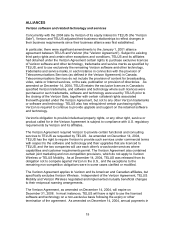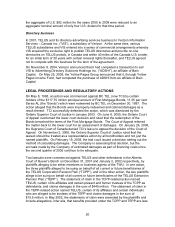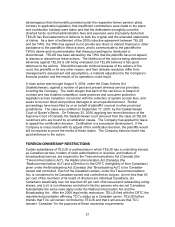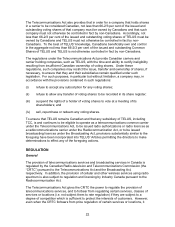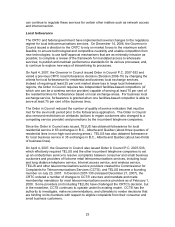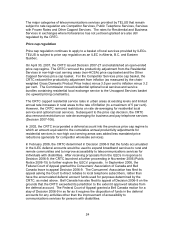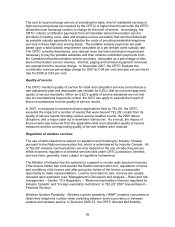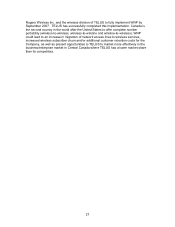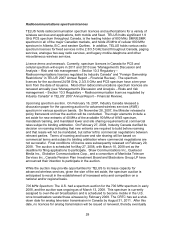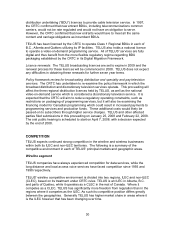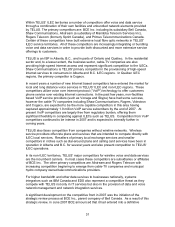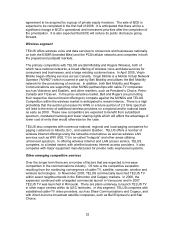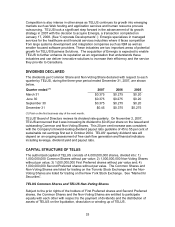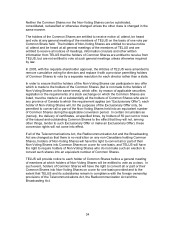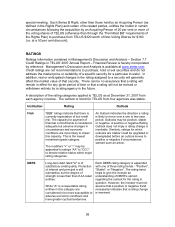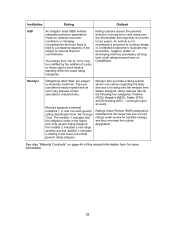Telus 2007 Annual Report Download - page 29
Download and view the complete annual report
Please find page 29 of the 2007 Telus annual report below. You can navigate through the pages in the report by either clicking on the pages listed below, or by using the keyword search tool below to find specific information within the annual report. 29
freeing up this spectrum. On January 19, 2008, Industry Canada initiated an auction
consultation process for spectrum at 700 MHz strictly covering public safety usage. A
consultation process for commercial use is expected to be announced sometime
between late 2008 and before the analog TV shut down in 2011. There is no guarantee
that the Canadian government will not reserve spectrum for new entrants or that it will
not, as was done in the U.S., adopt some elements of open access for some of this
spectrum.
2.5/2.6GHz: Industry Canada had previously announced plans to auction some
unlicenced spectrum at 2.6GHz and clawback spectrum at 2.5/2.6 GHz for mobile and
fixed wireless services. A consultation on this spectrum will be announced, presumably
sometime between late 2008 and before expiration of current licences in 2011. TELUS
does not currently hold spectrum in these bands.
800 MHz Re-banding: In 2004, the FCC released a Report and Order adopting a plan to
resolve interference to public safety radio systems in the 800 MHz band in the U.S.
Sprint Nextel’s ESMR system was identified as the primary contributor of this
interference. The U.S. is planning to realign the band so that Public Safety systems
would be relocated to the bottom of the 800 MHz band and Sprint Nextel’s ESMR
system would operate in the upper part of the band.
In Canada, the TELUS Mike (ESMR) network also uses this same frequency spectrum.
Because of the way licensing is carried out for the Mike network (i.e. each site is
analyzed and licenced individually), TELUS and Industry Canada have been able to
minimize the number of Public Safety interference issues to a few across the country
(compared to more than 1500 in the U.S.).
However, TELUS has an existing Special Co-Ordination Procedure (SCP), endorsed by
both Industry Canada and the FCC, wherein TELUS and Sprint-Nextel utilize each
other’s channels within their respective ESMR networks at specific border areas across
the country. These channels serve to increase the number of available channels
available to both networks to better serve the area. The re-alignment threatens the
continued use of the channels specified in the SCP.
While discussions with both the Canadian and U.S. regulators indicate that TELUS
should be able to continue to have access to a certain number of SCP channels in the
border areas, until such time as the U.S. announces their final decision, there is no
assurance that TELUS will be able to continue to use these channels.
Broadcasting services
The Broadcasting Act governs all types of broadcasting activities including commercial
off-air radio and television broadcasting, the operation of other programming services
such as specialty and pay television, as well as the distribution of television services
through cable or satellite undertakings.
The Broadcasting Act and its regulations give the CRTC the authority to issue licences
for specific categories of broadcasting undertakings and to regulate the content provided
and rates charged by each category of broadcasting undertaking. In August 1996, the
federal government issued its policy under which “telecommunications common carriers”
(as defined in the Telecommunications Act) would be allowed to apply for broadcasting


